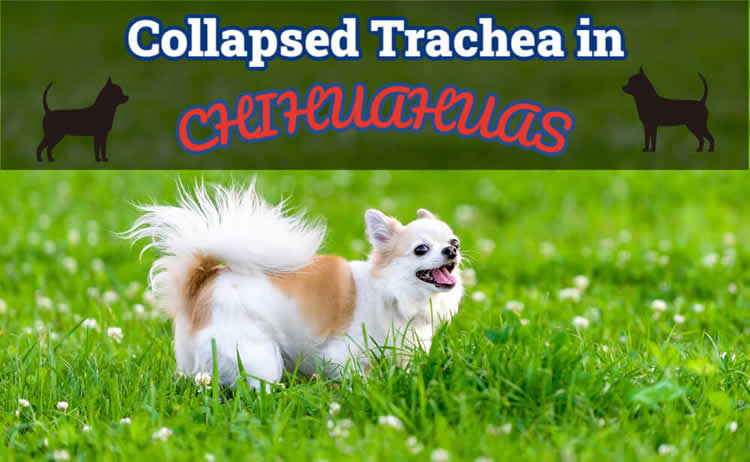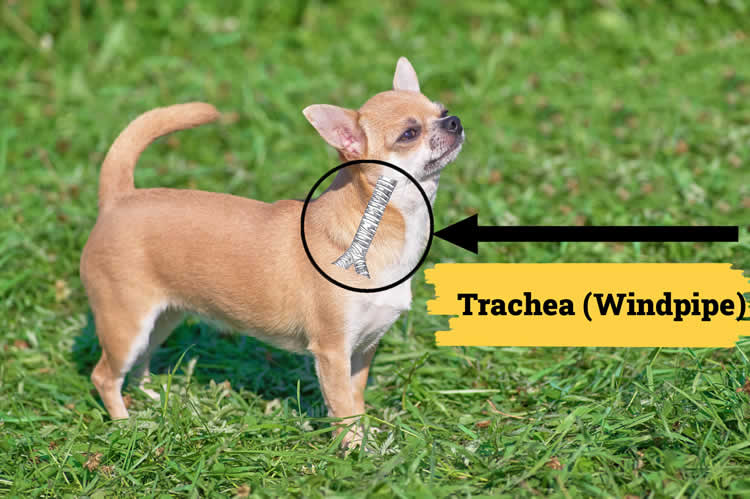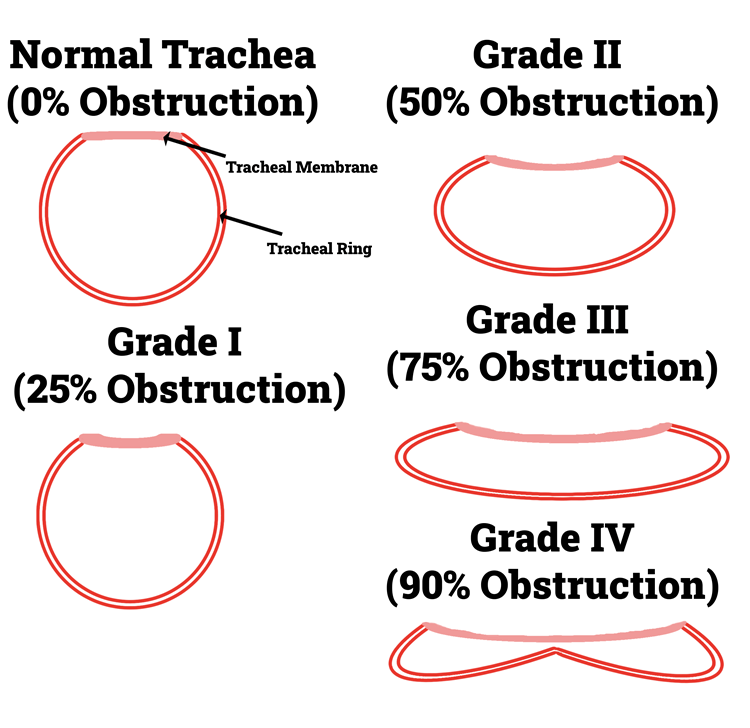
Does your Chihuahua experience episodes in which he coughs or gasps for air? He may be suffering from a collapsed trachea. As a brachycephalic breed, Chihuahuas are susceptible to various respiratory conditions.
Fortunately, most instances of persistent coughing are harmless. Wheezing or “reverse sneezing,” for instance, is characterized by spasms of the soft palate. When this flap of tissue at the roof of a Chihuahua’s mouth begins to spasm, the Chihuahua may wheeze while rapidly inhaling air through his nose. It’s a frightening sound for owners, but wheezing episodes such as this don’t cause pain and will typically subside within seconds.
Some Chihuahuas, however, may suffer from a more serious respiratory condition known as a collapsed trachea. If your Chihuahua experiences episodes of respiratory distress, you should familiarize yourself with the signs and symptoms of a collapsed trachea.
- What Is a Collapsed Trachea?
- Signs and Symptoms of a Collapsed Trachea
- The 4 Grades of Tracheal Collapse
- Causes of a Collapsed Trachea
- Diagnosis for a Collapsed Trachea
- Treatment Options for a Collapsed Trachea
- Collapsed Trachea vs Wheezing: What’s the Difference?
- Tips for Managing a Collapsed Trachea in Your Chihuahua
What Is a Collapsed Trachea?

A collapsed trachea is a respiratory condition that involves the weakening and narrowing of a Chihuahua’s trachea.
All dogs — along with other mammals, reptiles and birds — have a trachea. Also known as a windpipe, it’s a cartilaginous tube that connects the mouth to the lungs. Dogs inhale air through their trachea, and they exhale waste gases like carbon dioxide back out of their trachea. The trachea runs alongside the esophagus, which is a separate tube used to carry food and water to the stomach.
The trachea is comprised of C-shaped cartilage rings. A muscle membrane completes and closes the cartilage rings, resulting in a mostly cylindrical hollow passage. If the muscle membrane begins to sag or the cartilage rings lose their rigidity, the trachea will collapse.
Chihuahuas suffering from this respiratory condition may have trouble breathing. The sagging muscle membrane or loose cartilage rings won’t maintain the original shape of the Chihuahua’s trachea. As he inhales, the cartilage rings within the Chihuahua’s trachea will flatten. The inner circumference of the trachea will become smaller, meaning less space for air to pass into and out of the Chihuahua’s lungs.
Signs and Symptoms of a Collapsed Trachea
Chihuahuas suffering from a collapsed trachea may exhibit several signs and symptoms, most of which are breathing related. The narrowing of a Chihuahua’s trachea can make it difficult for him to breathe. When this occurs, you may notice the following.
Common signs and symptoms of a collapsed trachea in Chihuahuas include:
- Dry cough or “goose honking”
- Difficulty breathing
- Blue-colored tongue and gums
- Fainting
- Low energy
- Lethargy
- Dry cough or “goose honking”
- Sensitivity to pressure on the neck (yelping or coughing when you touch your Chihuahua’s neck)
The hallmark symptom of a collapsed trachea is “goose honking.” If your Chihuahua has a collapsed trachea, he will likely experience dry coughing episodes that mimic the sound of a goose honk.
The dry coughing episodes may only occur when triggered by stimuli, or they may worsen from stimuli. Stimuli may include pressure on your Chihuahua’s neck. Tugging on your Chihuahua’s collar, for example, may trigger a dry coughing episode. Other forms of stimuli include excitement, heat exposure, eating food, drinking too fast and exposure to airborne pollutants.
The 4 Grades of Tracheal Collapse

A collapsed trachea can be classified as Grade 1, Grade 2, Grade 3 or Grade 4 depending on the severity. Grade 1 is the least severe, whereas Grade 4 is the most severe.
- Grade 1: minor sagging of the muscle membrane, cartilage rings retain their shape and rigidity, airway approximately 25% obstructed.
- Grade 2: sagging of the muscle membrane increased, cartilage rings become loose and begin to flatten, airway approximately 50% obstructed.
- Grade 3: cartilage rings further flatten to the point where they nearly touch the sagging muscle membrane, airway approximately 75% obstructed.
- Grade 4: cartilage rings have completely collapsed and may be inverted, airway approximately 90% obstructed.
A study published in the Journal of Veterinary Internal Medicine found that Grade 1 and Grade 2 accounted for 21% and 46% of tracheal collapse cases, respectively.
Causes of a Collapsed Trachea
Tracheal collapse doesn’t have a single underlying cause. Because of its prevalence in toy breeds, though, many experts believe genetics play a role in its development.
All dogs can develop a collapsed trachea, but toy breeds have a much higher risk experiencing of this respiratory condition. Small dogs like the Chihuahua are often born with softer cartilage rings or fewer rings that predispose them to tracheal collapse.
Older Chihuahuas are more likely to develop a collapsed trachea than younger Chihuahuas. As they age, the cartilage rings within their trachea will weaken.
Injury to the neck can cause a Chihuahua’s trachea to collapse. Blunt force trauma to a Chihuahua’s neck may compress the cartilage rings or muscle membrane, making his trachea less rigid. Yanking on a Chihuahua’s collar with a leash can have a similar effect. It will strain the Chihuahua’s neck while potentially damaging the cartilage rings or muscle membrane.
You can protect your Chihuahua’s neck from injury by walking him with a harness rather than a collar. Harnesses distribute the pulling force throughout the Chihuahua’s body. As you pull the leash, the force will be spread across your Chihuahua’s body. Collars, conversely, focus the pulling force on the Chihuahua’s neck.

Obesity is a risk factor for tracheal collapse. Obese Chihuahuas have more pressure placed on their trachea than their healthy-weight counterparts. This excess pressure can weaken the trachea and increase the risk of tracheal collapse.
Heart disease is another risk factor for tracheal collapse. Chihuahuas suffering from heart disease may have an enlarged heart that presses the surrounding soft tissue against their trachea. Like with obesity, this pressure can weaken the Chihuahua’s trachea.
Environmental factors play a role in some cases of tracheal collapse. Exposure to airborne pollutants — cigarette smoke, volatile organic compounds (VOCs), mold spores, dust, etc. — may irritate the lining of a Chihuahua’s trachea. Over time, this irritation can lead to chronic inflammation that weakens the trachea.
Respiratory infections can increase the risk of tracheal collapse. Chihuahuas can develop bacterial or viral infections in their respiratory system, such as kennel cough. When left untreated, the infection may permanently damage the Chihuahua’s trachea.
Other breeds susceptible to a collapsed trachea include:
- Boston Terrier
- Brussels Griffon
- Cairn Terrier
- Cavalier King Charles Spaniel
- Dachshund
- English Toy Spaniel
- French Bulldog
- Jack Russell Terrier
- Lhasa Apso
- Maltese
- Pekingese
- Pomeranian
- Pug
- Scottish Terrier
- Shetland Sheepdog
- Shih Tzu
- Toy Poodle
- West Highland White Terrier
- Yorkshire Terrier
Diagnosis for a Collapsed Trachea
You can’t rely on the dry coughing or “goose honking” episodes alone to determine whether your Chihuahua is suffering from a collapsed trachea. Only a veterinarian can diagnose this respiratory condition, which is why it’s important to take your Chihuahua to the veterinarian if he exhibits any symptoms.
There are different ways to diagnose a collapsed trachea. Most veterinarians will begin with a standard physical examination and bloodwork analysis to rule out other conditions. Veterinarians may then use one or more of the following diagnosis methods:
- X-Rays: A form of electromagnetic-based imaging, X-rays allow veterinarians to take pictures of the inside of a Chihuahua’s body. X-rays, however, may not reveal a collapsed trachea. The condition may only show up when the Chihuahua inhales. If an X-ray is taken while the Chihuahua’s respiratory system is at rest, it won’t show up.
- Fluoroscopy: A more effective form of imaging for diagnosing a collapsed trachea is fluoroscopy. It involves the use of electromagnetic radiation to take images of the inside of a Chihuahua’s body — just like X-rays. The difference is that X-rays only create still images, whereas fluoroscopy creates real-time moving images. With fluoroscopy, veterinarians can see the Chihuahua’s trachea as he inhales and exhales. Fluoroscopy is also known as a “moving X-ray.”
- Bronchoscopy: Perhaps the most effective diagnosis method is bronchoscopy. It’s an endoscopic procedure that involves the use of a small video camera. During this procedure, the veterinarian will insert a fiber optic video camera into the Chihuahua’s trachea. Bronchoscopy is performed under general anesthesia, meaning the Chihuahua will be asleep throughout the procedure.
Treatment Options for a Collapsed Trachea

Treatment for a collapsed trachea will vary depending on the severity and cause. For minor cases, such as Grade 1 and Grade 2, veterinarians may recommend corticosteroids or bronchodilators.
Corticosteroids are potent synthetic versions of the same hormones produced naturally by a Chihuahua’s adrenal glands. With their anti-inflammatory properties, they can reduce swelling in the trachea and other parts of the body. The downside to corticosteroids is their potential for long-term side effects. When used over an extended period, they can interfere with the Chihuahua’s immune system while increasing the risk of infections.
Bronchodilators are used to relax the muscles in the respiratory system. They have a diuretic effect. When administered, bronchodilators will relieve muscle constriction in the airways, thereby allowing the Chihuahua to breathe a little more easily.
Cough medications are commonly used to treat tracheal collapse. Coughing is not only a symptom of this respiratory condition; it’s a trigger. Persistent coughing may irritate the Chihuahua’s trachea, causing it to become narrower. Cough medications work by suppressing the urge to cough, which may offer relief for Chihuahuas suffering from a collapsed trachea.
Some veterinarians may recommend anti-anxiety medications. When Chihuahuas experience anxiety, they’ll breathe more rapidly. Rapid breathing can cause the Chihuahua’s trachea to become narrower. The Chihuahua may then experience a dry coughing episode that increases his anxiety even further. Anti-anxiety medications have a calming effect that can promote a more open trachea.
Veterinarians may recommend treatment tailored to what caused or contributed to the Chihuahua’s collapsed trachea. If the Chihuahua is suffering from a respiratory infection, the veterinarian may recommend a round of antibiotics or antivirals. If the Chihuahua is obese, the veterinarian may recommend a weight management plan, such as reducing the Chihuahua’s caloric intake and increasing his physical activity levels.
Surgical Treatment
Surgery is typically only recommended for severe cases of tracheal collapse, such as Grade 4 or Grade 5, or Chihuahuas that don’t respond to conventional treatment methods.
There are different surgical procedures used to treat tracheal collapse. In the past, prostheses were commonly used to reinforce the trachea. Board-certified veterinary surgeons would insert C-shaped ring prostheses into the Chihuahua’s trachea. Due to the risk of potentially fatal complications, though, these surgical procedures have become mostly obsolete.
Today, one of the most common surgical procedures involves the placement of a stent. One study found that 96% of dogs suffering from a collapsed trachea showed improvement in their symptoms after this surgical procedure.
Stents are flexible tube-shaped medical devices that are designed to open a passage in the body. There are tracheal stents that, as the name suggests, are designed to open the trachea. During this procedure, the veterinary surgeon will place a self-expanding tracheal stent inside of the Chihuahua’s trachea to prevent it from collapsing.
There are risks associated with all surgical procedures, including stent insertion. The stent may break or fracture, or it may irritate the trachea. And even if a Chihuahua responds positively to surgery, he may require medication for life. Nonetheless, a tracheal stent can effectively open the Chihuahua’s trachea to ensure he can breathe.
Collapsed Trachea vs Wheezing: What’s the Difference?
Many owners assume their Chihuahua is suffering from a collapsed trachea when he is actually experiencing wheezing or “reverse sneezing” episodes or vice versa. Tracheal collapse episodes and wheezing episodes are similar, which can make it difficult for owners to distinguish between these two respiratory conditions.
Here are some videos showing a Chihuahua experiencing a collapsed trachea episode and a Chihuahua experiencing a wheezing episode.
Video of a Chihuahua experiencing a dry coughing episode from a collapsed trachea:
Video of a Chihuahua experiencing a wheezing or “reverse sneezing” episode:
Tips for Managing a Collapsed Trachea in Your Chihuahua
If your Chihuahua has been diagnosed with a collapsed trachea, you should consider the following tips to manage it. They aren’t a substitution for veterinary care, but these at-home management tips can have a positive impact on your Chihuahua’s respiratory condition.
- Follow the veterinarian’s instructions.
- Maintain a relative humidity level of 40% to 50% in your home.
- Don’t overexcite your Chihuahua.
- Vacuum and sweep the floors regularly.
- Install a high-efficiency particulate air (HEPA) filter in your home and change it once every few months.
- Manage your Chihuahua’s weight (see our growth chart to determine a healthy weight for your Chihuahua).
- Ensure your Chihuahua always has access to clean drinking water.
- Walk your Chihuahua on a leash and harness, not a collar.
- Avoid placing pressure on your Chihuahua’s neck when lifting or handling him.
- When taking your Chihuahua to a groomer, trainer, a new veterinarian or any other professional, let them know about his collapsed trachea immediately.
References:
https://www.acvs.org/small-animal/tracheal-collapse
Does your Chihuahua have a collapsed trachea? Let us know in the comments section below!
my chihuahua “Taquito” is 5 years old, last knight he had an epesode of maybe reverse sneasing or colapsed tracia, dont know what it was apart from I was very worried that he was choking. what is the emergency procedure during this episode or what can I do to help him?